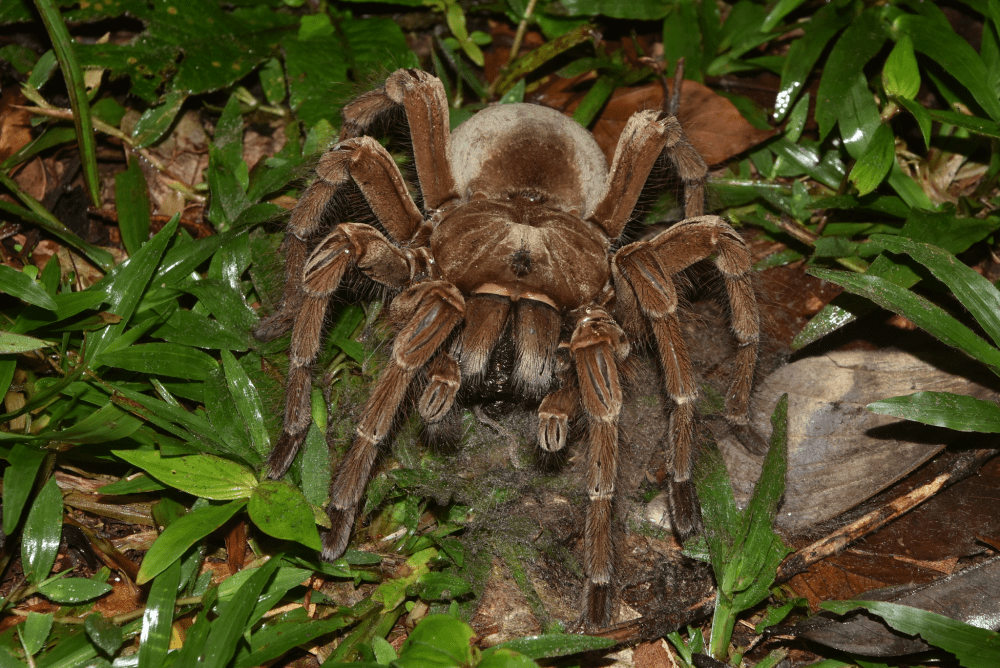The biggest spider in the world prowls the Amazon in search of insects, rodents, and even birds that it can sink its one-inch (2.5 centimeter) fangs into before dragging back to its burrow. With a leg span of almost a foot (0.3 meters) and weighing around 170 grams (6 ounces), it’s a hefty arachnid that has earned a mighty name: the Goliath birdeater.
These stealth-hunting spiders live in South American forests where they lay out mist webs around their burrows, which are often built inside fallen trees, sometimes elevated off the ground. You might think that dragging dinner home to such a spot might be hard work for a spider, but being such an enormous arachnid, the Goliath makes small work of it.
The Biggest Spider In The World
The Goliath birdeater (Theraphosa blondi) is widely considered the biggest spider in the world with its eight exceptionally fuzzy legs stretching up to 28 centimeters (11 inches) making it about the size of a dinner plate. It also has an absolute unit for a carapace, the arachnid’s answer to a torso, measuring around 12 centimeters (4.75 inches).
There is a spider with a bigger leg span: the huntsman, whose legs just pip the Goliath at 30 centimeters (11.8 inches) across, but it’s smaller by other measures (still big enough to drag in a possum for dinner, though).
What do Goliath birdeaters eat?
Despite their name, they don’t exclusively eat birds. In fact, they more commonly dine on insects, amphibians, and small mammals (like this opossum) but birds are by no means off the menu. A Goliath birdeater was spotted opportunistically eating a common scale-backed antbird (Willisornis poecilinotus) that had become entrapped in researchers’ mist nets, triggering them to set down new recommendations for ensuring studied animals don’t become a free meal for passing predators.

Goliath birdeaters are capable of killing birds without the aid of human research tools, but the difficult part comes in catching them. Most birds are pretty quick and given these tarantulas’ lousy vision, they probably see a low success rate when hunting birds compared to easier prey like bugs and frogs.
As for what dares eat the biggest spider in the world, snakes, other tarantulas, and mammals like coatis may dabble in a Goliath birdeater. However, the Goliath doesn’t go down without a fight. They have specialized hairs on their legs so that, should a predator approach, they can rub their legs together and send harpoon-like hairs armed with stinging barbs pinging into their sensitive eyes. Those same hairs, known as urticating hairs, also line the females’ egg sacs so that predators won’t be tempted to tuck into a big bag of baby spiders.
How does the biggest spider in the world mate?
Male Goliath birdeaters will knit together what’s known as a sperm web when they want to start making babies. The structure is a tent-like web that is open on both ends and attached to a rock or tree stump. The male will crawl into the sperm web upside-down so he can lace it with semen for the female to wander over and pick up.

In case you’d like to see what the babies of the biggest spider in the world look like, the Wellington Zoo in New Zealand became the first zoo in 20 years to hatch a clutch of T. blondi back in 2020. A video shows the chicken-nuggies-for-spiderlings waggling their little legs in the air after hatching at the zoo. In the wild, there can be as many as 150 spiderlings in a single egg sac.
Oh, and in case you’re curious, the biggest spider in the world apparently has a shrimp-like flavor, something we know because Goliaths are eaten in South America. They’re prepared by singing off the hairs on their exoskeleton before being roasted in banana leaves as a source of protein that’s good for the planet. However, while T. blondi isn’t on the IUCN Red List for Endangered Species, some fear they may be under threat due to their increasing popularity in the pet trade.
On the subject of absolute units, did you see the world’s heaviest fish get weighed by a forklift?
Source Link: The Biggest Spider In The World Fires Weaponized Hairs At Potential Predators